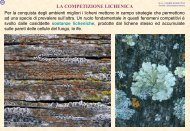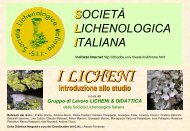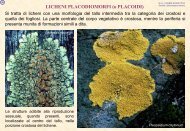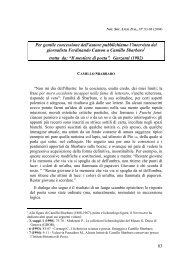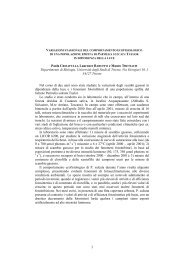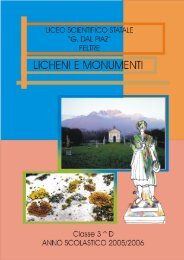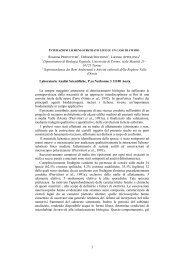KEY to terricolous lichens - italic
KEY to terricolous lichens - italic
KEY to terricolous lichens - italic
You also want an ePaper? Increase the reach of your titles
YUMPU automatically turns print PDFs into web optimized ePapers that Google loves.
marginal, prominent Cells of lower cortex arranged in vertical rows, Conidia 5-7 µ<br />
long, Squamules 10 mm wide<br />
Catapyrenium rufescens<br />
Thallus squamulose, reddish brown, thick, K-, C-, KC-, P-. Squamules >10 mm wide,<br />
rounded, flattened, smooth, adpressed <strong>to</strong> the substratum. Edge up-turned, undulate.<br />
Upper cortex paraplectenchyma<strong>to</strong>us. Perithecia frequent, laminal, pyriform, half<br />
immersed, not flattened. Paraphyses absent. Perithecial wall pale throughout. Asci<br />
unitunicate, cylindrical. Ascospores 1-celled, hyaline, ellipsoid, thin-walled, 8 per<br />
ascus, 15-20(22) x (7) 7.5-9(10) µ. Conidia ellipsoidal. Pho<strong>to</strong>biont chlorococcoid.<br />
Pycnidia marginal, prominent Cells of lower cortex not arranged in vertical rows,<br />
Conidia 3-5 µ long, Squamules without hairs. Rhizohyphae pale. - Note: on vertical<br />
seepages of calcareous rocks, almost always with colonies of cyanobacteria, more<br />
rarely on plant debris, calcareous soil, <strong>terricolous</strong> or epilithic bryophytes.<br />
39 Squamules (2)3-6 mm wide 40<br />
40 Squamules without hairs. Conidia bacilliform.<br />
Catapyrenium imbecillum<br />
Thallus squamulose, brownish, K-, C-, KC-, P-. Squamules (2)3-6 mm wide, rounded,<br />
flattened, smooth, adpressed <strong>to</strong> the substratum. Edge up-turned, undulate.<br />
Undersurface black, brown at the periphery. Upper cortex paraplectenchyma<strong>to</strong>us.<br />
Perithecia frequent, laminal, pyriform, half immersed, not flattened. Paraphyses<br />
absent. Perithecial wall pale throughout. Asci unitunicate, cylindrical. Ascospores 1celled,<br />
hyaline, ellipsoid, thin-walled, 8 per ascus, (12)14-18 x 6-8 µ. Conidia<br />
bacilliform. Pho<strong>to</strong>biont chlorococcoid. Pycnidia marginal, prominent Cells of lower<br />
cortex not arranged in vertical rows, Conidia 3-5 µ long, Rhizohyphae pale. - Note:<br />
known from the Austrian Alps, and from several isolated stations in southern Europe,<br />
<strong>to</strong> be looked for in the Alps.<br />
40 Squamules with very thin hairs, at least at the periphery. Conidia ellipsoidal.<br />
Catapyrenium pilosellum<br />
Thallus squamulose, brownish, thin, K-, C-, KC-, P-. Squamules (2)3-6 mm wide,<br />
rounded, flattened, smooth, adpressed <strong>to</strong> the substratum. Edge up-turned, undulate.<br />
Upper cortex paraplectenchyma<strong>to</strong>us. Perithecia frequent, laminal, pyriform, half<br />
immersed, not flattened. Paraphyses absent. Perithecial wall pale throughout. Asci<br />
unitunicate, cylindrical. Ascospores 1-celled, hyaline, ellipsoid, thin-walled, 8 per<br />
ascus, (10)12-17(19) x (5) 5.5-7(7.5) µ. Conidia ellipsoidal. Pho<strong>to</strong>biont chlorococcoid.<br />
Pycnidia marginal, prominent Cells of lower cortex not arranged in vertical rows,<br />
Conidia 3-5 µ long. Rhizohyphae pale. - Note: on calciferous soil rich in humus, often<br />
growing amongst bryophytes, several Italian records require reconfirmation.<br />
41 Apothecia lecanorine, with a thalline margin containing algal cells 42<br />
41 Apothecia non lecanorine, without a thalline margin 44<br />
42 Ascomata dark. Squamules < 2 mm diam.<br />
Phaeorrhiza nimbosa<br />
Thallus squamulose, from brownish <strong>to</strong> pale ochraceous yellowish, sometimes fainly<br />
pruinose, thick, K-, C-, KC-, P-. Squamules rounded, flattened, smooth, contiguous,<br />
adpressed <strong>to</strong> the substratum, non imbricate. Undersurface dark, with a dense mat of<br />
rhizohyphae. Upper cortex paraplectenchyma<strong>to</strong>us. Apothecia frequent, lecanorine,<br />
sessile, 1.2 mm diam. Surface black, sometimes faintly pruinose. Margin thin.<br />
Paraphyses distinctly thickened above. Asci clavate. Ascospores 2-celled, not hyaline,<br />
ellipsoid, thick-walled, 8 per ascus, 18-22 x 8-10 µ. Pycnidia dark, immersed. Conidia<br />
bacilliform. Pho<strong>to</strong>biont chlorococcoid. Rhizohyphae dark. - Note: on naked earth,<br />
dead mosses and plant debris on more or less calciferous ground, often in windexposed<br />
situations, an arctic-alpine species, common in the Alps.<br />
42 Ascomata neither bright nor dark-coloured. Squamules >2 mm diam. 43<br />
43 Medulla P-. Specimens with a P- medulla belong <strong>to</strong> v. pseudocrassa (Mattick)<br />
D.Hawksw.<br />
Squamarina cartilaginea<br />
25



